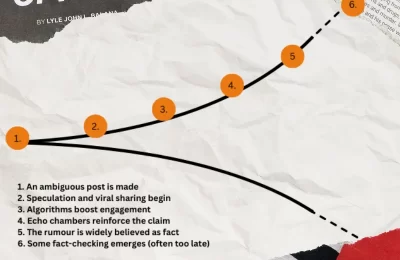How to write brand copy that engages – not lectures.
Ok, there is said it, become better copy-writers guys. And yes you can use ChatGPT for it but use it properly, not lazily.
Us social marketers, we go on and on about how social media is mean to be a conversation, how it’s meant to be authentic (and yet still you’re using long emdashes and imo bad CTAs?).
Specifically brands who are better off not diluting their brand stories with half-arsed jumping on trends, way too late anyways, should be focusing on copy writing, and I’m talking about copy writing for organic social here.
1. Stop talking at people!
The biggest problem with broadcasting-style brand copy is that it assumes a passive audience. It pushes messages out without considering whether people want to receive them. The result? People tune out.
Here’s what happens when brands talk at their audience:
- It feels impersonal. Consumers crave connection, but one-way communication creates distance.
- It lacks engagement. No conversation means no reason for people to interact.
- It’s easy to ignore. A social media feed is cluttered – content that doesn’t invite participation gets scrolled past.
2. Instead reframe brand copy to provide value
To move from broadcasting to conversing, brands must shift their mindset from telling to inviting, showing rather than just stating . The goal is to create a space where your audience feels encouraged to participate, respond, and co-create the experience with you.
So how can that be done? I will show you how to get from boring copy to something that feels a bit more valuable to your audience.
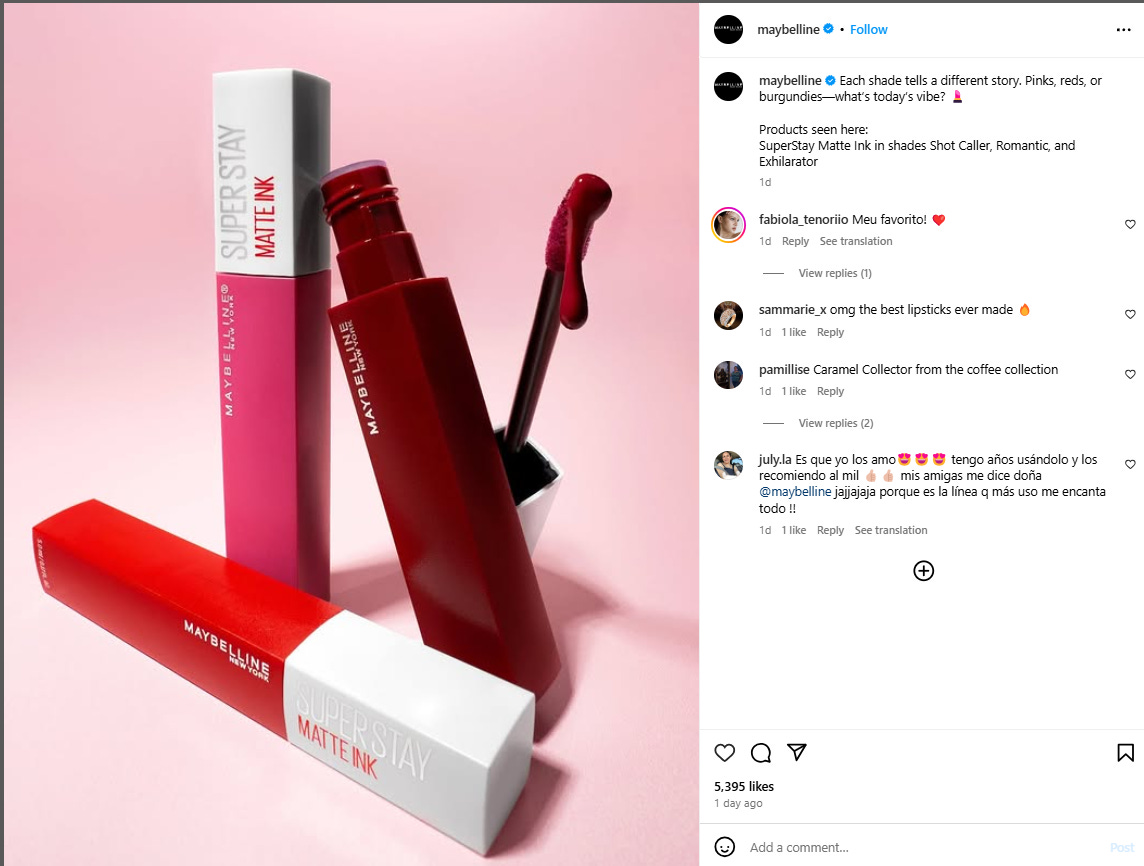
Center the audience, not just the brand
Instead of writing from a company-first perspective, ask: What’s in this for my audience? The best-performing brand copy speaks to the audience’s interests, emotions, or experiences.
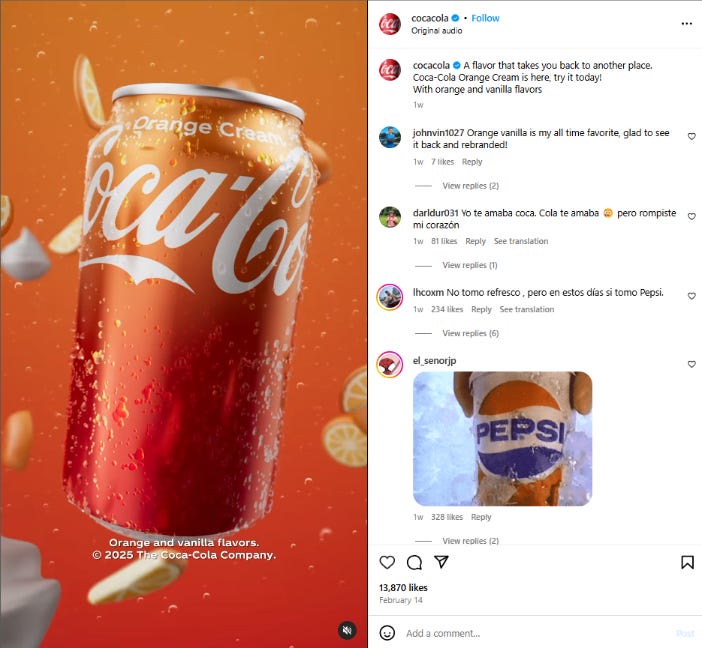
Take this example by Coca Cola, the engagement on the post definitely showcases that Coca Cola’s audience is excited about the new launch, and this is something they appreciate seeing on social. However, a few tweaks to their copy: “A flavor that takes you back to another place. Coca-Cola Orange Cream is here, try it today!” could have turned it from a post that tells to one that invites.
A more engaging approach, like “Have you ever tried an orange-vanilla combo? Our brand-new Coca-Cola Orange Cream is a first – let us know your first impression!” would spark curiosity and encourage participation.
Do the call-to action right.
Instead of making statements, ask questions that invite your audience to share their experiences or opinions. This naturally sparks conversation and increases engagement.

Let’s break down why I don’t think that the copy on Maybelline’s post above is done well.
Each shade tells a different story = this feels too vague and at the same time
Pinks, reds, burgundies = ok, we do see that, but how is it connected to the CTA?
— = I know, I know, but if you only use the long emdash since you started using ChatGPT for copywriting, it is not part of your TOV, it may actually come across as inauthentic!
Whats today’s vibe? = at this point I’m tuned out.
Overall, I see what the post is trying to achieve, but it feels more filler than killer (or maybe it will kill the engagement). With just a few tweaks the copy could feel a lot more audience-centric.
Dependent on the brand tone of voice you could go for a copy that comes straighter to the point, and tries to align itself more with ho the audience is feeling, in a more direct way:
”Monday vibe check. Which one matches your energy today?” or “Which shade speaks to your mood today – bold, confident, or playful?”
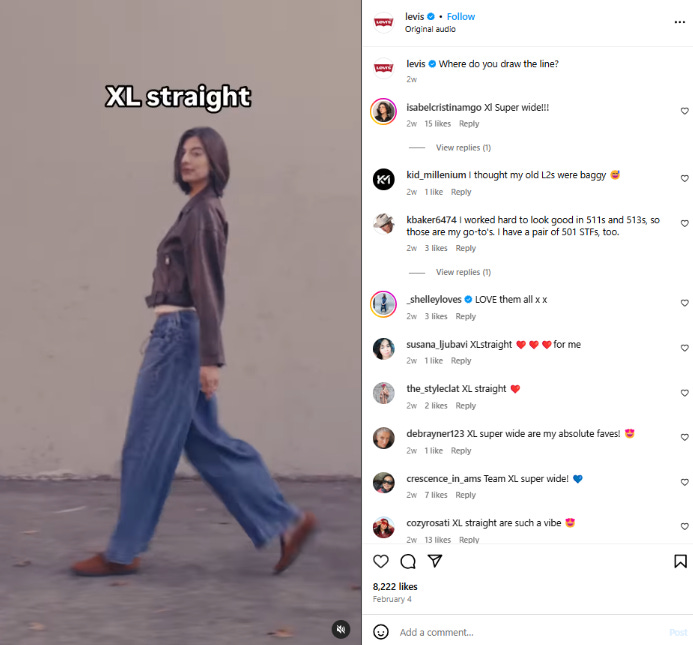
The Levis post above is a great example of show don’t tell, with copy that’s straight to the point. You can criticise that the copy itself is interchangeable with other brands (yes it is) BUT the post managed to tick of some pretty valid boxes, showcasing product range in an exciting way AND drive engagement in the comments. And the comments speak for themselves.
Tap into emotive & sensory language
People connect with content that makes them feel something. Using sensory words – especially those that evoke sound, texture, or movement – can make your copy more immersive. A nice example is the quote by a perfumer used below on the Aesop Instagram, which brings more context to the visual.
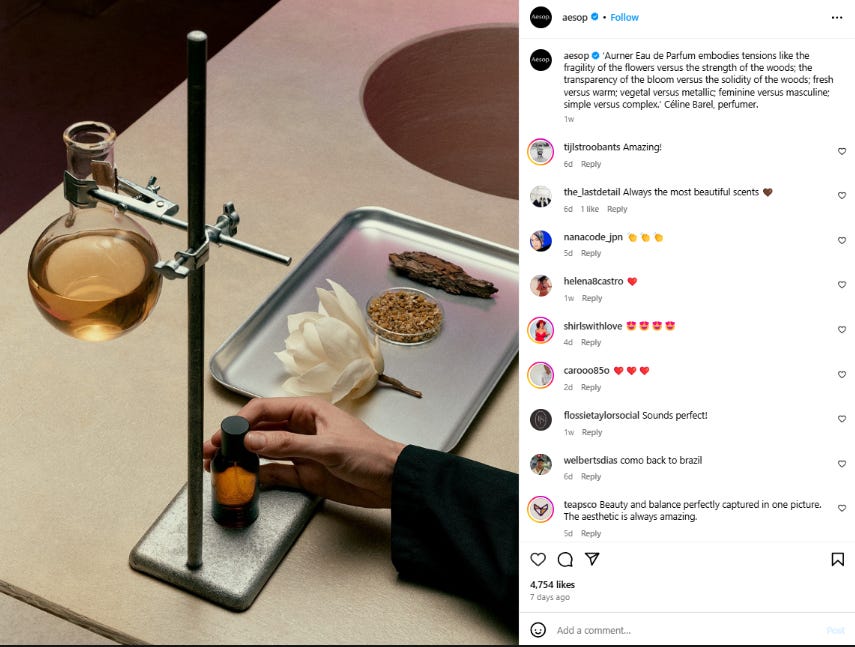
Keep in mind what the algorithm prioritises
Instagram prioritises content that keeps users watching, engaged or share the post. To boost your visibility, use strategic hooks that encourage people to linger.
Techniques to increase watch time:
- Start with an intriguing statement or question
- Create anticipation
- Use storytelling
3. Making social content social
At its core, social media is about interaction, not just consumption. The brands that succeed are those that foster community, encourage participation, and make their audience feel heard. Or they are providing great editorial and serial content ticking of the boxes of entertainment, education and inspiration… bringing extensive value to their audience.
A checklist for better organic social copy-writing
1️⃣ What’s the objective of this content? (Is it meant to entertain, educate, inspire, or evoke emotion?)
2️⃣ What value does this post bring to the audience? (Why should they care?)
3️⃣ Does the copy feel like a conversation or a broadcast? (Am I talking with my audience, not at them?)
4️⃣ Is my CTA clear and engaging, but not engagement bait? (Does it prompt action in a natural, compelling way?)
BONUS: Does the copy create an emotional or sensory connection? (Does it make the audience feel something?)


